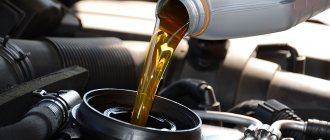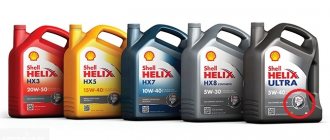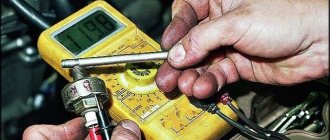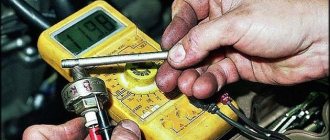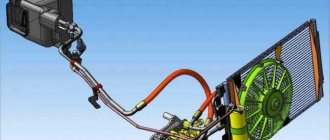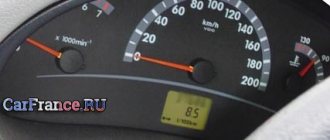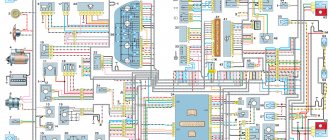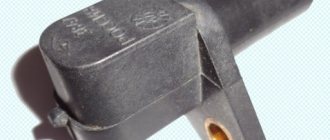The use of engines with a distributed injection system on Lada cars made it possible to stabilize the operation of the unit and reduce fuel costs in urban conditions to 10 liters per 100 km. High fuel consumption on a VAZ 2114 with an 8-valve injector indicates incorrect operation of the power system or exhaust gas emissions. The owner of the car can independently find faults and make repairs in the parking lot or in a garage.
High gas consumption of VAZ 2110 and all about it
Today, high gas consumption of the VAZ 2110 is a fairly common problem among car owners. High gasoline consumption for a VAZ 2110 can occur for various reasons. However, before you “treat” the car, it is worth finding what is causing the car to function poorly. Indeed, if a car begins to overuse fuel, then this is bad, as undesirable consequences may appear.
Problems with the chassis
On the chassis side, the following factors most influence gasoline consumption:
- insufficient tire pressure;
- incorrectly adjusted camber and toe;
- incorrectly selected wheel size.
Everything is simple here: regularly check the tire pressure, camber/alignment, put on your “swallow” only the sizes recommended by the manufacturer. Following these obvious rules will help you avoid high gas mileage.
Disadvantages of the VAZ 2110 car
VAZ 2110 high fuel consumption
VAZ 2110 is a sedan with four doors. The peculiarity of the car is its original and unusual design. The production of this brand was first discussed in 1996. It is still being created today. The car is in high demand due to the fact that:
- They are made of quality materials;
- They can overcome any obstacles;
- They cope with any trails and conditions.
Note: By the way, they say that the amount of fuel it consumes also depends on the roads on which the VAZ 2110 travels. Therefore, sometimes it is impossible to deal with the problem of high gasoline consumption of the VAZ 2110.
Today the car is manufactured under the Bogdan 2110 brand in Ukraine. The VAZ 2110 was initially produced in several modifications. The engine is a four-cylinder, runs on gasoline, and has a volume of 1596 cc. Because of this, the car reaches speeds of up to 180 km/h.
VAZ 2110 what is the gas consumption
The downside of the car is its high fuel consumption. Of course, this drawback also occurs in other cars. Additionally, it can be fixed. However, first you need to know the factors that contributed to the emergence of this discrepancy. As noted earlier, they are different and there are a lot of them. Therefore, it is better to understand everything thoroughly or take the car to a car service center.
Reasons for high fuel consumption
VAZ 2110 gas consumption is high
Since the driver has decided to repair the car himself, the reasons for the expense may be as follows:
- Reason 1 - off-road. So, if a motorist lives in a village or rural area, then you should not hope that his car will “eat little fuel.” When driving off-road, a huge load is placed on the car, so it cannot function properly. In this case, it is not worth bothering the car with repairs. Perhaps it will drive better, but it is unlikely to consume less fuel. Of course, there is a way out: you need to move to the city.
VAZ 2110 gas consumption is high
Note: if a motorist likes to drive short distances (say, to and from the store), then he will also have a problem with fuel. The car starts, wasting fuel. When it stops, gasoline is also consumed. The result is a large amount of wasted gasoline. Low speeds are also not the best option. If a beginner is just learning to drive, then he should choose cars that consume very little fuel.
- Reason 2 - sensors. This is a common reason why modern cars start using more fuel than necessary. The pressure problem occurs due to improper operation of the sensors that calculate the normal volume of the air-fuel mixture.
VAZ 2110 increased gasoline consumption
Note: If at least one of these sensors is faulty, the mixture may turn out to be too “lean” or “rich”, which will lead to high gasoline consumption of the VAZ 2110. You can talk about this malfunction only after diagnosing the car. However, it is possible to determine the presence of this problem using the sensor overhaul method.
- Reason 3 – fuel system pressure. In this case, an increase in pressure is quite rare, while a decrease is very common. Eventually, the engine's power (see How to Repair an Engine Properly) decreases, so it runs longer to keep the car running properly. As a result, high gasoline consumption of the VAZ 2110 is observed.
- Reason 4 - the injector is faulty. It is very important to periodically monitor engine operation. Otherwise, its efficiency will decrease over time, therefore, it is quite possible that the engine will begin to “triple”. This can be caused by uncleaned engine injectors (they need to be cleaned from time to time). Because of this, the resulting mixture is of low quality. Therefore, the amount of gasoline sprayed increases significantly. Thus, the car begins to consume a lot of fuel.
- Reason 5 – increase or decrease in engine temperature. The normal engine temperature for car operation is 100 degrees (plus or minus 2 degrees). Very often the engine overheats, so the mixture is too discharged. As a result, engine power is greatly reduced, which is why fuel consumption is high. If the engine temperature, on the contrary, is lowered, then fuel consumption increases because gasoline is needed to increase it.
- Reason 6 – refueling. Is the driver sure that the gas stations are pouring in the amount of fuel he expected? We must be vigilant. They also cheat at gas stations.
There are many photos and videos on the Internet, thanks to which you can repair a car, or rather some of its components, with your own hands. Of course, everyone wants to save money, because the price of repairs at a car service center is very high. Therefore, everyone believes that they can handle it, but they must be careful. Instructions found on the Internet are, of course, good, but if the car breaks down even more, the cost of repairs will increase significantly.
Source
Clogged air filter
With absolutely any engine, of any size: both 2.2 and 1.6, high fuel consumption is possible if the air filter is clogged. The problem is not only that less oxygen enters the combustion chamber. The operation of the engine is much more affected by the fact that the incoming air flow meters give the computer incorrect information.
As a result of the error, the ECU incorrectly calculates the engine load. This means that the mixture is prepared based on incorrect data. In both 1.6 and 2.2 engines, high fuel consumption is ensured in this case. However, this does not depend on the engine size, but on a 5 liter monster the difference is more noticeable.
Why does the consumption exceed the passport values?
Consumption exceeding the passport figures is fraught with reasons, often interrelated. This automobile disease can be identified by diagnosing its operational parameters, technical condition, and external factors:
- Dark exhaust, loud pops from the muffler.
Based on 100 km of travel, additional losses are also tied to engine displacement and the number of valves.
Sequence of diagnostic work
Before intending to bring consumption to factory values, it is advisable to narrow the range of reasons, starting with electronic, fuel systems, sensors, filters.
The sequence of inspection stages for the VAZ-2110 includes:
- Removing and cleaning the fuel pump diaphragm.
Clean the fuel pump diaphragm and change the mesh
Cleaning the injector nozzles
Adjusting the thermal clearance of the valves
Checking the speed device
Sources of increased consumption on the VAZ-2110
The source of increased flow is often:
- Air filter, integrity of high-voltage wires, weak spark plug.
- Clogged injectors.
- Malfunction of spark plugs, air consumption sensor, excess pressure in the fuel system.
- Defective camshaft fixation sensor.
- Malfunction of the regulator (idle speed).
- Defect (burnout) of one of the exhaust valves or several.
Fuel consumption may increase due to exhaust valve burnout
Low compression can cause increased fuel consumption
The cause may be problems associated with external operating factors, for example:
- Cabin air conditioning, the consumption of which within the city is 10÷20% of total consumption.
- Frequent gear changes.
- Low tire pressure (negatively affects the handling of the car), wide-profile tires, spoilers, low-beam headlights, external trunk, interior audio system.
The trailer helps increase fuel consumption by 10%
To eliminate the causes of increased gasoline consumption, it is more economically feasible to trust a specialized service.
A brief historical excursion for connoisseurs
The main differences in appearance are as follows: original headlights, additional brake light, new spoiler, etc. As for the “filling”, there have been many more changes:
- the europanel device is a front panel with two LCD displays, equipped with an overboard thermometer;
- convenient placement of emergency information in the center of the panel;
- optimal interior ventilation;
- steering column adjustment;
- heated seats;
- electric windows;
- folding rear seats.
Considering all of the above, the owners of the VAZ 2114 can only be envied. The ride quality is stable, the control unit is reliable, the steering wheel no longer blocks part of the dashboard and leaves enough space for the driver to sit comfortably. If necessary, you can easily convert your hatchback into a station wagon by simply folding the rear seats. Thus, the car becomes a utility vehicle with a large body capacity. Comfort is also an undoubted advantage due to the same heated seats and thoughtful ventilation. All this sounds great, and it would be so if not for one big drawback - the fuel consumption of the VAZ 2114. The reasons may be different, and they will be discussed further. But the fact remains: sometimes 10 or even 13 liters of gasoline are needed per 100 km, which cannot but upset car owners. Fuel consumption is actually high. Since it is necessary to protect lovers of the domestic automobile industry with all our might, we will try to understand the issue and find a way out.
Elimination methods
The mass air flow sensor (MAF) is considered a target device for detecting fuel loss. A machine with the sensor disabled may perform well. This agility is the beginning of the end of the mass air flow sensor. The device is turned out and the voltage is checked with a tester (the ignition is on).
Checking the mass air flow sensor
Based on the individuality of each car, the voltage should not exceed 1.03 V. Otherwise, the sensor is replaced. A VAZ-2110 with a volume of 1.6 liters and a speed of, for example, 2000 requires about 25 kg of air. Therefore, as this value increases, gasoline consumption increases. Hence the priority of diagnosing the air flow sensor.
- A faulty fuel system simultaneously increases the level of harmful emissions into the atmosphere, reduces power, and turns off the engine when idling. The situation requires checking the fuel pressure supplied to the injectors using a pressure gauge (preferably with a 7-fold division range).
Measuring fuel pressure
Overspending is accompanied by:
- Coolant temperature . A defect in this sensor results in a “lean” or “rich” fuel mixture.
- A malfunctioning throttle clamp sensor directly affects the idle speed and throttle response of the vehicle.
The throttle position sensor affects the engine idle speed
Excessive fuel consumption is accompanied by a malfunction of the ignition coil
Excessive fuel consumption depends on many factors, such as timely repairs and vehicle maintenance.
Source
How to adjust the carburetor on a VAZ 2107
And, therefore, the smaller the engine volume for which the nozzle was designed, it means that the less gasoline will flow through it into the atomizer, which means that its consumption will be less. Indirect signs accompanying high fuel consumption are black carbon deposits on the spark plugs, pops or shots in the muffler, increased engine idle speed, black exhaust from the muffler, or exhaust with a persistent smell of gasoline, etc.
Fuel consumption rates for all modifications of the VAZ 2110 and the main reasons for increased appetite
Any modern car is equipped with many different sensors that allow the driver to know about the condition and performance of certain components. And the VAZ 2110 car is no exception; in this article we will talk about what sensors are used in it and what their location is.
As you know, the VAZ 2110 injector with 8 or 16 valves is significantly superior to the carburetor version in many ways. At least because in this case the supply of gasoline, as well as the combustible mixture, is regulated by electronics. Accordingly, the use of electronics implies the use of many different regulators and controllers. Their breakdown can lead to certain consequences, so the car owner should always know what certain regulators are responsible for. Below we consider almost all VAZ sensors that are in the top ten.
The power unit of the "tens" is controlled using the ECM - an electronic system. This system must always know how much air needs to be supplied for a certain volume of gasoline. These two parameters are closely related to each other, since with their help a combustible mixture with the required density is formed in the engine power unit. After the system determines the required volume of air, it begins to select the appropriate amount of gasoline. As for the regulator, it is responsible for the suction volumes.
Air controller for "ten"
This controller has certain disadvantages, in particular:
- its performance may be impaired if the controller is exposed to moisture;
- if the car is moving at lower speeds, the controller can produce higher readings;
- as practice shows, at idle the air regulator does not work entirely correctly;
- when starting the power unit, certain difficulties may arise;
- the power unit may stop abruptly for no reason after an increased power mode;
- Gasoline consumption during vehicle operation may increase.
We've dealt with the shortcomings, now let's talk about how the device functions:
- The controller design consists of several sensitive elements installed directly in the line itself through which the air flow passes. One of these components is designed to fix the temperature of the air flow, and the other two are always heated to the required parameters.
- To correctly determine the air flow rate, the principle of measuring electrical power is used to maintain the desired temperature level.
- The air regulator controller has a special mesh installed in the line, designed to filter the air flow.
- Thanks to this, the sensor can transmit the necessary data to other regulators designed to activate certain modes. Subsequently, these regulators either change or support the loads.
Air regulator
The ECM is the electronic engine control system. And she needs to know how much air to supply for the amount of fuel supplied. These two parameters are closely interrelated because they allow you to create an optimal air-fuel mixture.
Having determined the amount of air, the system determines the required volume of gasoline. The air sensor is responsible for the suction volumes. The disadvantages of this device include:
- Due to exposure to moisture, performance is impaired;
- At low speeds, the sensor produces increased readings;
- The device cannot operate normally when idling;
- Problems may arise when starting the engine;
- After increased power mode, the engine may stop abruptly;
- Fuel consumption increases.
How does this sensor work? Let's try to figure it out.
- The regulator design includes three sensitive components that are installed in the air flow. One of the elements determines the temperature of the intake air, and the other two heat up to the required levels.
- Air flow is determined by measuring the power of electricity to maintain the required temperature.
- The regulator has a mesh that is mounted in the air flow.
- All this allows you to transfer information to controllers, which, in turn, enable certain modes to change or maintain loads.
Article on the topic: Technical features of the VAZ 2114
Model VAZ 2103
The amount of air increases, the mixture becomes leaner and the ECU, based on the readings of the oxygen sensor, increases the injection time, thereby greatly increasing consumption. Unfortunately, if the primitive old sensors could only work in two modes, normally or not normally, and, accordingly, lit a check when something was wrong, then with the new ones everything became more complicated.
Coolant temperature sensor
Removing the fan regulator on a VAZ 2110 On a VAZ 2110, sensors can be used for different purposes, but most of them are mounted in the engine compartment.
On an 8 or 16 valve engine, the fan sensor is a device designed to activate the fan. We are talking directly about a fan designed to cool a hot engine. The controller turns on automatically when the power unit reaches a certain temperature. But it can also turn on when the engine is off. At first, this fact may be alarming for many owners of the “ten”, but there is nothing wrong with it, so there is no need to worry.
It is necessary to highlight the advantages of this controller:
- As practice has shown, the fan sensor is one of the most reliable vehicle devices, since its design is based on a solid filler. When the ambient temperature increases, this filler begins to expand.
- The design of this device also includes a special spring-loaded lever. Thanks to this component, no defects occur during the operation of the regulator.
- The device prevents sparks from appearing, which is especially important for ensuring vehicle safety.
- In fact, this type of regulator itself is reliable. If you buy a high-quality device, then in the future you will notice that it will function for quite a long time; you can forget about the need to replace it for the next few years.
Crankshaft regulator
New crankshaft controller for the “ten” Depending on the type of car, on a 16- and 8-valve engine, the location of all controllers may be different.
However, all of these devices combine into one functioning system, and the crankshaft adjuster is no exception. Thanks to this controller, the electronic engine management system of the “tens” can independently determine at what point to supply gasoline and a spark through the spark plugs in order to ignite the combustible mixture. In fact, the design of the device is a magnet, as well as a coil of thin wire. The crankshaft sensor has certain advantages:
- As practice shows, at “tens” this regulator can work for quite a long time. Its service life does not decrease even as a result of using the vehicle’s power unit under increased loads.
- The crankshaft adjuster works in conjunction with the crankshaft pulley.
- If the device fails, the engine may not be able to start. Or, if the regulator breaks down, the speed parameters will be reduced to 3.5 thousand per minute.
This controller is installed on the oil pump, actually at the very top of the shaft teeth. Or rather, one millimeter from the cloves. You can learn more about how to replace this controller yourself from the video below (the author of the video is the channel In Sandro’s Garage).
High fuel consumption of the injection VAZ 2110
If we apply simple arithmetic and the mode of normal use of the car, we will get the following situation: Consumption in the city in summer is permissible 11 liters per 100 km, the trip from home to work is permissible 7 km. In winter, let's say warming up for 15 minutes and the same trip on a warm engine, while warming up the engine, let's take a consumption of 1.2 liters per hour, a total of 300 ml of gasoline will burn in 15 minutes, for a trip we get a consumption of 770 ml per 7 kilometers, total total fuel consumption will be 1,070 ml with the same mileage of 7 km, and this is no longer 11 liters, but 15.2 per 100 kilometers
If you change the data and warm up longer, or make a shorter trip, then the results will change. Then there are several other options with the same data, city consumption in the summer is 11 liters, fuel consumption when warming up is 1.2 liters (in fact, it can be even more, because 1.2 liters are usually already on a warm engine at idle) Warm up 15 minutes, travel 4 km, total winter consumption 18.5 liters per 100 km Warm up 30 minutes, travel 20 km, total winter consumption 14 liters per 100 km
As the mileage increases, of course, the difference with summer consumption decreases... So everything is clear about the old man, but with your mileage of 100 km a day, of course, such consumption in winter, without taking into account traffic jams, should not exist.
Of course, another 11 liters in the city if you don’t take into account traffic jams. If we take into account traffic jams and the time spent standing in them, then the consumption can easily even without warming up can approach 20 liters, let’s say a trip of 7 kilometers, a total time of 45 minutes... With a normal travel time of about 15 minutes without any traffic jams, we have 30 minutes of engine idling, using the same calculation (7 km trip with a consumption of 11 liters 770 ml of gasoline, 30 minutes of warming up at 1.2 liters per hour 600 ml of gasoline) we get a consumption of 19.5 liters per 100 km. It's simple.
I noticed a change in consumption depending on what time I leave home. If I leave at 7:15, then I arrive at work at 7:35, the journey takes 20 minutes, I arrive early, it seems like I could sleep, but if I leave at 7:25, then the journey no longer takes 20 minutes, but 35 .and I arrive tick by tick at 8:00, the option when being late is not acceptable. The consumption is as follows: Departure at 7:15 - 2 minutes of warming up on the spot, 5 minutes in traffic jams, a total of 7 minutes of idling and 7 km of travel at 11 liters per 100 km, a total of 13 liters of consumption. Departure at 7:25 - the same 2 minutes of warming up before departure, but already 20 minutes in a traffic jam, and we get an idle time of 22 minutes and a final consumption of 17.3 liters.
The calculation can probably be clarified, perhaps 11 liters in the summer is already taking into account traffic jams a little, you can do the calculation with 10 liters, this will reduce the numbers a little, but by noting the departure time, the travel time, the mileage from a full refueling to the next full refueling, I came to the conclusion that the calculation absolutely fair...
— The EPHH system is faulty: Exhaust system
Increased fuel consumption due to a damaged air conditioning system Although the compressor is driven by a serpentine belt, the air conditioning system has very low efficiency and fuel consumption increases significantly. The palm belongs to the anti-advice, which may interest the car owner right now is the use of cheap types of gasoline instead of expensive ones or those recommended by the manufacturer.
| Engine | Consumption (highway) | Consumption (city) | Consumption (mixed cycle) |
| 1.3 l 4-mech (gasoline) | 7.8 l/100 km | 11.5 l/100 km | 10.5 l/100 km |
| 1.4 l 5-mech (gasoline) | – | 9 l/100 km | – |
| 5.2 l/100 km | 8.9 l/100 km | 7 l/100 km | |
| – | 8.5 l/100 km | – | |
| 9.5 l/100 km | 12.5 l/100 km | 11 l/100 km |
Coolant temperature indicator
Antifreeze or coolant is used to cool the engine. To ensure proper operation of the power unit, the coolant also has its own controller. In its functionality, this regulator is vaguely reminiscent of the choke that is equipped with 8- and 16-valve carburetor engines of the “ten” and other vehicles. The sensor itself is designed to monitor the temperature of the consumable.
Installing a new antifreeze sensor
In fact, this device also provides fuel regulation. If the power unit is running cold and has not yet warmed up, it will receive more gasoline for normal operation. Readings about the coolant temperature are displayed on the control panel in the vehicle interior. In accordance with these indicators, the driver will always be able to find out about the overheating of the unit by the way the sensor arrow on the dashboard begins to move into the red zone.
The antifreeze temperature sensor periodically fails; it is characterized by the following malfunctions:
- Loss of electrical contact inside the controller, resulting in its inoperability.
- The device is installed in such a way that it may be exposed to moving elements, particularly the accelerator pedal cable. It would be even more correct to say that the cable does not act on the sensor itself, but on its wires, which in fact can lose insulation as a result of long-term use.
- Often the regulator breaks down if the ventilation device starts to function on an engine that is not warmed up.
- If the motor is overheated, it may be difficult to start.
- If the fuel temperature controller fails, it can lead to increased gas mileage. If you encounter one of these problems, then to ensure normal operation of the car engine, you need to replace the controller. Detailed replacement instructions are presented in the video below (author - REPAIR VAZ 2110, 2111, 2112).
Checking the temperature sensor VAZ 2110
> The most important thing you need to know about the temperature sensor of the VAZ 2110 is that there is not one. The VAZ 2110 has two temperature sensors: - Coolant indicator temperature sensor. This is a sensor designed to display information about engine temperature on the instrument panel. It doesn’t affect anything else, it’s not connected anywhere - it only affects the temperature indicator on the panel. — Coolant temperature sensor connected to the ECU. This sensor radically affects the operation of the car engine. It is from this that the control program knows the engine temperature and sets the injection duration to the injectors. It is precisely this sensor that is used by the ECU to turn on the fan of the VAZ 2110 engine cooling system. Therefore, with high fuel consumption, a boiling engine, or a non-working fan, it is this sensor that needs to be checked.
Temperature sensor VAZ 2110
The temperature sensor is a thermal resistance, that is, a resistance that changes depending on the engine temperature. The sensor is installed in the exhaust pipe of the cylinder head near the thermostat. It twists inside the pipe and its sensitive part interacts directly with the coolant. The sensor connected to the injector has two contacts, and the temperature indicator has only one contact.
Location of temperature sensors VAZ 2110
As a rule, checking VAZ 2110 temperature sensor The sensor has two contacts - the resistance between them must be measured with a multimeter. Checking the temperature sensor of the VAZ 2110: 1) When the engine is cold, remove the connector from the sensor and check whether it is oxidized. Then use a multimeter to measure the resistance. We put the connector in place. 2) Start the engine and warm it up. If the temperature indicator works correctly from its temperature sensor, then it will show us the correct temperature. 3) Turn off the engine, remove the connector again and measure the resistance of the temperature sensor. It should become less than it was on a cold engine. On a cold engine at a temperature of about 0 degrees, the sensor resistance should be about 10 kOhm. At a temperature of 90 degrees, the sensor resistance will be 240 Ohms. 4) When the resistance of the temperature sensor is less than 240 Ohms, the ECU should start the cooling system fan. To check this, you need to take a 100 Ohm resistor and connect it to the contacts of the temperature sensor connector. When the resistance of the connector contacts closes, the fan will begin to rotate; when it opens, it will turn off. 5) If the resistance of the sensor does not change depending on the engine temperature, then the sensor is faulty and needs to be replaced. 6) If the cooling system fan does not turn on even on a hot car and closing the contacts of the sensor connector with a resistance of 100 Ohms, the fan also does not start, then you need to check the fuse, the fan relay on the block to the left of the passenger seat under the glove compartment. Where the ECU is installed. 7) Anyone interested can drain the antifreeze, unscrew the sensor and take it home. Place it in boiling water and measure the resistance - it should be 100-200 Ohms. Although the same thing can be done by car. temperature gauge sensor does not spoil life much, but it should still be in good order. Checking it is similar to the method described above - measuring the resistance at different temperatures of the VAZ 2110 coolant.
Temperature indicator VAZ 2110
Replacing the temperature sensor of a VAZ 2110: 1) We replace the temperature sensor on a cold engine. Unscrew the cap of the expansion tank and drain the antifreeze to the level of the temperature sensor. 2) Unscrew the sensor with a 19 mm wrench. Screw in a working sensor in its place. 3) Add antifreeze to the previous level, put the connector on the sensor, and close the expansion tank with a lid. 4) Start the engine and see if antifreeze is leaking through the temperature sensor. What to pay attention to: There is no need to confuse the temperature sensors of the VAZ 2110 with each other. The sensor that is connected to the ECU is installed higher, on the exhaust pipe. The temperature gauge sensor is below, screwed into the engine housing in the area of the cylinder head. You can use resistors of different values. By connecting it to the sensor contacts, the arrow on the panel should show different temperatures. 10 kOhm - 0 degrees, 240 Ohm - 90 degrees, 100 Ohm - 130 degrees.
Speed sensor
8- and 16-valve “tens” are also equipped with a speed sensor. Thanks to this device, the electronic engine control system receives information about how fast the vehicle is moving. The sensor itself is installed on the vehicle's gearbox. As practice has shown, on VAZ 2110 cars this controller is characterized by fairly high reliability and a long service life.
But domestic developers could not do everything perfectly, so this device is characterized by several malfunctions:
- If a component fails or does not work correctly, then when idling, the power unit may turn off on its own.
- A failed regulator can partially affect the speed characteristics of the vehicle. Of course, if the device breaks down completely, the driver will not be able to know how fast it is moving.
Two speed controllers
Carburetor device. Engine malfunctions
| Reasons for high fuel consumption in a car Additives also cannot greatly affect the efficiency of the engine, otherwise they would first of all be used in aviation and in cargo transportation, because fuel costs there are much higher than when driving small cars. The palm belongs to the anti-advice, which may interest the car owner right now is the use of cheap types of gasoline instead of expensive ones or those recommended by the manufacturer. |
| How to reduce the fuel consumption of a carburetor engine Typically, problems in this system are accompanied by unstable idling of the engine or its persistent desire to stall at forced idle when driving in high gear with the gas pedal released. Inaccuracies in the readings of the device that monitors the fuel level in the tank, as well as errors in the speedometer and driving style that increases consumption, which is typical for most young motorists. |
- 90 km/h;
- 120 km/h;
- driving in an urban environment.
Engine malfunctions • Believe me, friends, even owners of expensive supercars also think about fuel consumption.
Phase sensor
This sensor is not installed on 8-valve engines; it is present only on 16-valve versions of the “ten”. The main purpose of the controller is to provide the necessary data to the power unit control system. In accordance with these data, the system determines at what point in time and where to inject fuel, into which specific cylinder. Every owner of a VAZ 2110 should know where this device is located. If you open the engine compartment of the car, you will see that the regulator is located on the right side of the neck for filling the engine fluid.
In principle, if the regulator breaks, nothing bad will happen if you look at it from the point of view of the integrity of the vehicle. But failure of the controller will in any case provoke an increase in gasoline consumption. This is due to the fact that the electronic control system of the internal combustion engine will independently switch the gas distribution mechanism to standby mode. Accordingly, gasoline will begin to be supplied to all cylinders of the engine at once. And at first, the driver may not even know about it until he diagnoses the regulator or measures fuel consumption.
New phase sensor for VAZ 2110
Naturally, such a model of the domestic automobile industry as the “ten” is not the most modern and advanced car in terms of electronics. However, machines of this model are equipped with a wide variety of regulators and controllers. In this article, we did not talk about all the devices, but only about the most basic ones that every motorist should know about. You can find more detailed information in other articles on our website or in the service book for your car.
Idle speed control
Today, in urban environments, drivers simply cannot do without idling. Therefore, every car, including the VAZ 2110, is equipped with an idle speed sensor. Incorrect operation or failure of this regulator will significantly complicate driving, because it will cause the engine to stop even during the shortest stops. So if the controller fails, and this is not uncommon in VAZ 2110 cars, it needs to be changed as quickly as possible.
Removing the idle air control
The main purpose of this type of regulator is to support the speed required for normal operation of the power unit. Thanks to the device, the driver can always make a short stop as a result of changing the incoming air volume. As for the location, this controller is installed on the throttle line. In particular, we are talking about an anchor stepper motor, which is equipped with two windings.
When a corresponding signal is received on one of the windings, a special needle moves forward one step and backwards one step. Thanks to the worm gear, the device rotates, which is produced using a stepper motor, thus converting this movement into translational. The rod itself, namely its conical part, is located in the line through which the air flow is supplied.
Thanks to the functioning of the rod, the system adjusts the idle speed of the power unit. The rod from the device, as mentioned above, can be retracted or extended. In this case, it all depends on what kind of pulse will be supplied from the regulator. The controller itself allows you to adjust the frequency at which the engine crankshaft will rotate when the machine is stopped for a short time.
In addition, the controller controls the incoming air flow, which bypasses the throttle in the closed position. When the engine is warmed up, the regulator, by controlling the movement of the rod itself, at idle speed allows you to maintain the required crankshaft speed. In this case, the load and condition of the power unit do not play a role.
Main causes... Engine malfunctions
| How to Reduce Consumption on a VAZ 2107 ~ Rationale: try to drive towards the traffic light with the intention of accelerating at the green signal when the car has not yet completely stopped. They pour 10 liters into the tank and set the daily counter to zero, drive with engine warm-ups, stops, both on city roads and on the highway, while they want to drive 120 kilometers, which you will agree is stupid. |
- To restore the mesh filter, the following procedures must be performed. To do this, use a fuel pump, that is, pump the carburetor until the shut-off valve closes. After this, it must be dismantled and washed with solvent and dried thoroughly. It is also worth considering here that if dips appear, this may result in a loss of power.
- Now they begin to clean the float chamber, for this they use a regular rubber bulb. And after washing, the device must be dried, and you cannot use rags for wiping, as lint remains. And there are situations when the jets become clogged.
- Don’t forget to check the locking needle; it can also be cleaned using a blower. This procedure is performed by ear to determine if there are any air leaks; if a problem is identified, it is better to immediately replace the valve body or the needle itself.
- To adjust the float system, you need to check its position; if it is displaced, you can move it a little using a special holder. But to do this, first check that the needle valve is closed. After this, you can set the float and hatch gasket. It is best to achieve a resolvable size of 15 mm. All these procedures can be carried out either with the carburetor removed or repaired on the car.
- Now you need to adjust the starting system, in this case the air filter is also removed, start the engine and remove the choke, but not much. As previously mentioned, up to 3.5 thousand revolutions.
- Next comes the idle speed adjustment, that is, the quality screw, first tighten it completely, and then make several turns clockwise. Then the engine is warmed up to the required procedure and the choke is completely removed, and listen to how the engine works. If it starts to stall, then the quality screw should be turned a little in the opposite direction. The main thing to remember here is that all work with the screws should be carried out when the car is idling, otherwise the throttle valve will begin to open.
Owners of new modified VAZ cars with a single electronic control unit may encounter excessive consumption of gasoline at the injector. One of the reasons may be incorrect pressure in the fuel system. Recheck the car's engine management system; there may be a malfunction in its operation.
Also, one of the key problems with fuel consumption can be the failure of an injector or temperature or oxygen sensor. The fuel consumption of a Lada 2107 per 100 km with an injector (engine volume 1.5 liters) in the city in winter should be 9.5-13 liters, and in summer – 7.5-8.5 liters.
The carburetor also consists of several components, and in order to configure it correctly, you need to know several basic ones:
Carburetor DAAZ-2107-1107010-20 “OZONE” (view from the throttle valve drive side): 1 — throttle valve body; 2 — carburetor body; 3 — pneumatic drive of the throttle valve of the second chamber; 4 — carburetor cover; 5 - air damper; 6 — starting device; 7 — three-arm air damper control lever; 8 — telescopic rod; 9 - lever limiting the opening of the throttle valve of the second chamber; 10 — return spring; 11 — pneumatic drive rod.
- Chamber with float.
- The econostat serves as an enricher and is located in the second combustion chamber.
- Idling.
- Idle valve.
- Throttle valve.
- Dispenser system.
- Transition from one system to another.
- Removal of crankcase gases.
If you know all these components, then you can independently repair, clean and adjust the carburetor on the VAZ 2107. Of course, there are many more systems here, but the ones presented will be enough to carry out repairs yourself. And before all the work, it’s worth remembering that it is the systems presented that can break, and nothing else, so don’t go too deep.
Replacement process
Replacing the coolant temperature sensor VAZ 2110
To check and replace the temperature device, you will need the following tools and materials:
- Socket wrench set to “19”;
- Sealant;
- Coolant;
- Copper washer.
Note. The temperature sensor is located in the VAZ 2110, often in the intake manifold near the thermostat housing, rarely in the cylinder head. It is installed so that the tip comes into contact with the coolant. Only in such cases is his signal correct. If the coolant level is low, the sensor readings may be incorrect.
